My goodness.
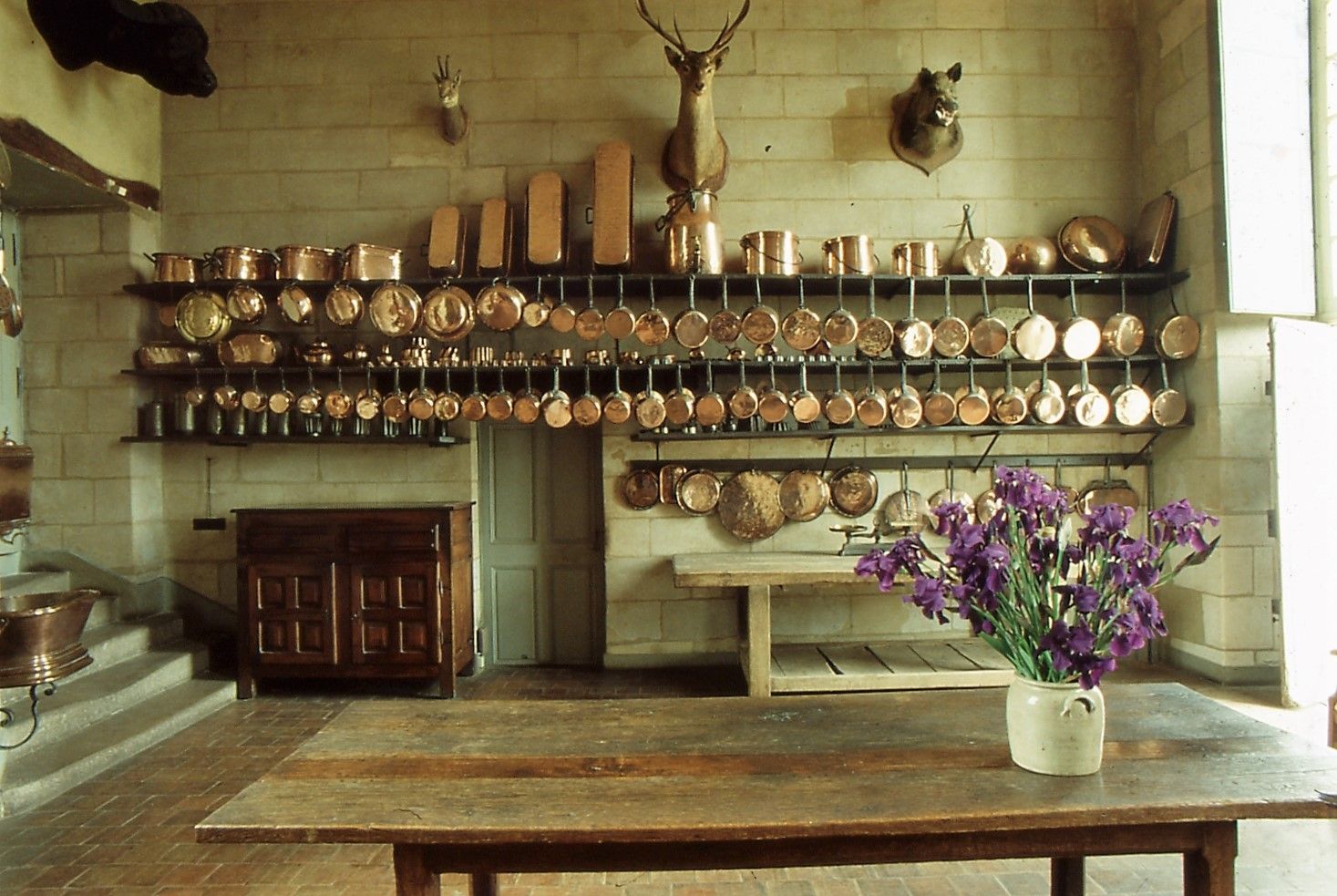
This must be one of the most photogenic arrays of copper on the Internet. It belongs to the kitchen of the château de Montgeoffroy near the town of Mazé in the Loire Valley of France.
The place has an interesting history. The castle’s website states that the property was owned in the 13th century by Geoffroy of Chateaubriand, presumably Geoffroy V (c. 1216-1262). I don’t know what happened in the succeeding centuries but by the 15th century the Grandière family owned the land and there was a residence described as a château. In 1676, Erasmus de Contades purchased the property and it has remained with the family to the present day.
The 18th century building that we see today is the work of his grandson Louis Georges Erasmus de Contades (1704-1795), a highly decorated maréchal in the army of France under Louis XV and Louis XIV. Louis Georges, born at Montgeoffroy, decided towards the end of his military career to renovate the property into his retirement home. In 1772 he commissioned a three-year project to construct a new château commensurate with his glorious military career. The structure retained the U-shape, moat, and twin round towers of the 15th century structure but was otherwise a “modern” 18th-century creation of the architect Jean-Benoît Vincent Barré. It is a lovely place with a long allée approach to a pleasingly symmetrical façade. The extensive wooded parklands remain intact.


The château de Montgeoffroy is a time capsule of 18th century French architecture and interior decoration. Most relevant to our interests is the kitchen with its wall of beautifully presented copper. Here is another view.
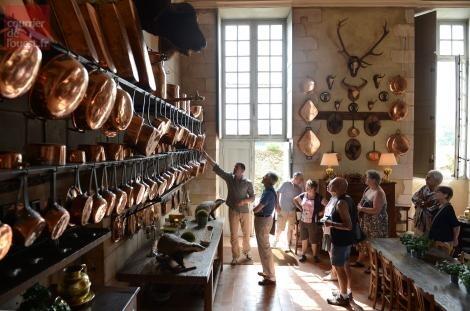
The château’s website features the detail photo below of a section of the hanging pieces. There’s a lot going on here, and I’m not just referring to the taxidermied badgers. Let’s take a closer look.

Here’s what I see. (I added the numbers to the photo for reference.)
- This pan has what looks like a forged iron handle and what could be four rivets. I’d put this at early 1800s, perhaps late 1700s.
- The flat baseplate suggests this handle is forged also. I’d guess this is early 1800s.
- This baseplate is a little thicker, so I don’t think it’s forged. I suspect it’s wrought, but I’d have to take a closer look to be sure. I’d date this at early to mid 1800s.
- Another flat baseplate. I think it’s forged, and early 1800s.
- There’s that puffy cast iron baseplate we know so well! I’d put this piece at late 1800s, maybe early 1900s.
- To be honest I’m not entirely sure what’s going on with this one because the dark marks along the outer rim of the pan are hard to interpret. Is that a messy tin job? Could it be the remnants of an English-style tinning? I think the baseplate is small with rivets arranged in a triangle, but it’s also possible this is a very early antique pan with a forged baseplate that has cracked a bit. I can’t really be sure. If the lid hanging behind it truly is its mate, then they could be primitive (18th century) pieces.
- The baseplate is relatively flat and the rivets are narrow-set — I think this handle is forged or wrought. The hanging loop is closer to round than to a teardrop shape. I’d say this is an early 1800s piece and I’m not entirely confident it’s French.
- At first glance this pan looks a lot like 7, but compare the spread of the rivets. The pans are about the same size to my eye, but the rivets on this one (8) are spread farther apart than those on 7. 8’s rivets have the French aesthetic that I recognize. I think the handle is forged — that’s a rat-tail loop — and the piece is likely early to mid 1800s.
- This looks like an English piece to me. The arrow-shaped baseplate on both the pot and its lid look to me like the sharp-point English design, along with the short length of the lid’s handle. The dovetailing on the base also has much wider crenellations. The handle looks cast to me, so I’d put this at mid-1800s to early 1900s.
- There’s something going on with the lower edge of the baseplate. It looks like the notch I see on forged handles with a baseplate formed from cutting a slit into the shaft, spreading the pieces apart, and flattening them. But if that were the case I’d expect to see a rat-tail hanging loop, and yet the loop on this one looks like a clean cut (or cast) hole. So I’m just not sure. This pan has been through some things, though, as we can see in the patch repair to the pan’s chin. That spot on the base opposite the handle is usually where damage shows up on old heavily-used pans. Anyway, if this handle is forged, I’d put this piece at early to mid-1800s; if it’s cast, then mid to late 1800s.
- This one makes 10 look like a spring chicken. That’s a forged handle for sure — the baseplate is flat, and also it has the rat-tail hanging loop that I don’t see on 10. And if I am not mistaken here, this pan has at least one patch repair to an earlier patch repair. It’s actually sort of nice to see it — someone took the time to repair this at least three separate times. I’d estimate this piece at early 1800s.
- I had to tweak the settings on my photo editor to brighten up the handle area on this one, but it’s still a bit of a mystery. It looks like this had a semicircular handle riveted on at the very edge of the rim, subsequently removed and replaced with a simple ring handle mounted to a bracket using one of the rivet holes. I can’t figure out how this was used. Is it a serving platter? If so, it would have to be quite thick to have enough structural rigidity to support weight. Is it a sort of universal lid that could be placed on a stockpot or some other large pan? Perhaps, but without a functional handle it would be awkward to maneuver when it heated up. I just don’t know.
- The shape of the handle on this lid looks like the classic French aesthetic. I wish I could see the hanging loop a little more clearly, but at the moment I think this is a cast iron handle and therefore late 1800s into the 1900s. It’s had a significant repair, and it’s certainly possible that a recent-era cast iron handle was attached after an earlier handle failed.
- This looks like a forged handle to me. Look at the odd rivet pattern — there are two rivets closely spaced at the center of the lid. I haven’t seen this before and it’s either idiosyncratic to a maker I don’t know, or it’s quite early — late 1700s to early 1800s.
- Another lid with the same unusual handle as 14. The disk of this handle is differently crafted, however; both 14 and 15 are couvercles à degré with an indent around the rim, but 15’s indent is far more pronounced than that of 14. I think these lids are too early to have been stamped by machine, which means the rims were added by hand with a hammer. I’d guess 14 and 15 were made by different smiths and possibly different times as well. Of the two I’d guess 15 is a little younger, maybe early to mid 1800s.
- I don’t even have to see all of 16 to know what it is: it’s the lid for an oval cocotte. Scroll up to the very first photo in this post and look at the left end of the second shelf for the two oval-shaped pans standing up on their side — I think this lid might match the smaller of the two, the one on the far left. Without seeing the handle material I can’t really speculate on its age.
What strikes me is the variety, and bear in mind that what we see above is just a slice of what’s hanging on that wall. My assessment is that this assortment of copper was not assembled for the sake of appearances by an interior design consultant; I think these are actual pieces that this kitchen was using in the 18th and 19th centuries. I would not be surprised if several of the pieces hanging on the wall today date from the completion of the chateau’s construction in 1776.
The mystery for me is how this collection — if it is is original and authentic to the château — has stayed intact for two hundred and fifty years (and counting). How did Montgeoffroy survive the French Revolution? Did the castle’s western location spare it from the ravages of WWI and WWII? And on a more pedestrian note, what moved the family to preserve these fragile pieces, instead of chucking it all to upgrade to a sturdier 20th century batterie de cuisine? The family lives there to this day and I expect there are living quarters elsewhere in the complex, likely with a working kitchen outfitted with more modern conveniences. But perhaps the same instinct for reverence that compelled the family to preserve the 18th and 19th century furnishings also protected the historic kitchen as well.
All I know is that I’m glad that this place exists and that the family is sharing it with us. I hope they recognize the treasures they have hanging on the walls. If you’ve visited Montgeoffroy or are familiar with its history, I’d love to hear more about it.
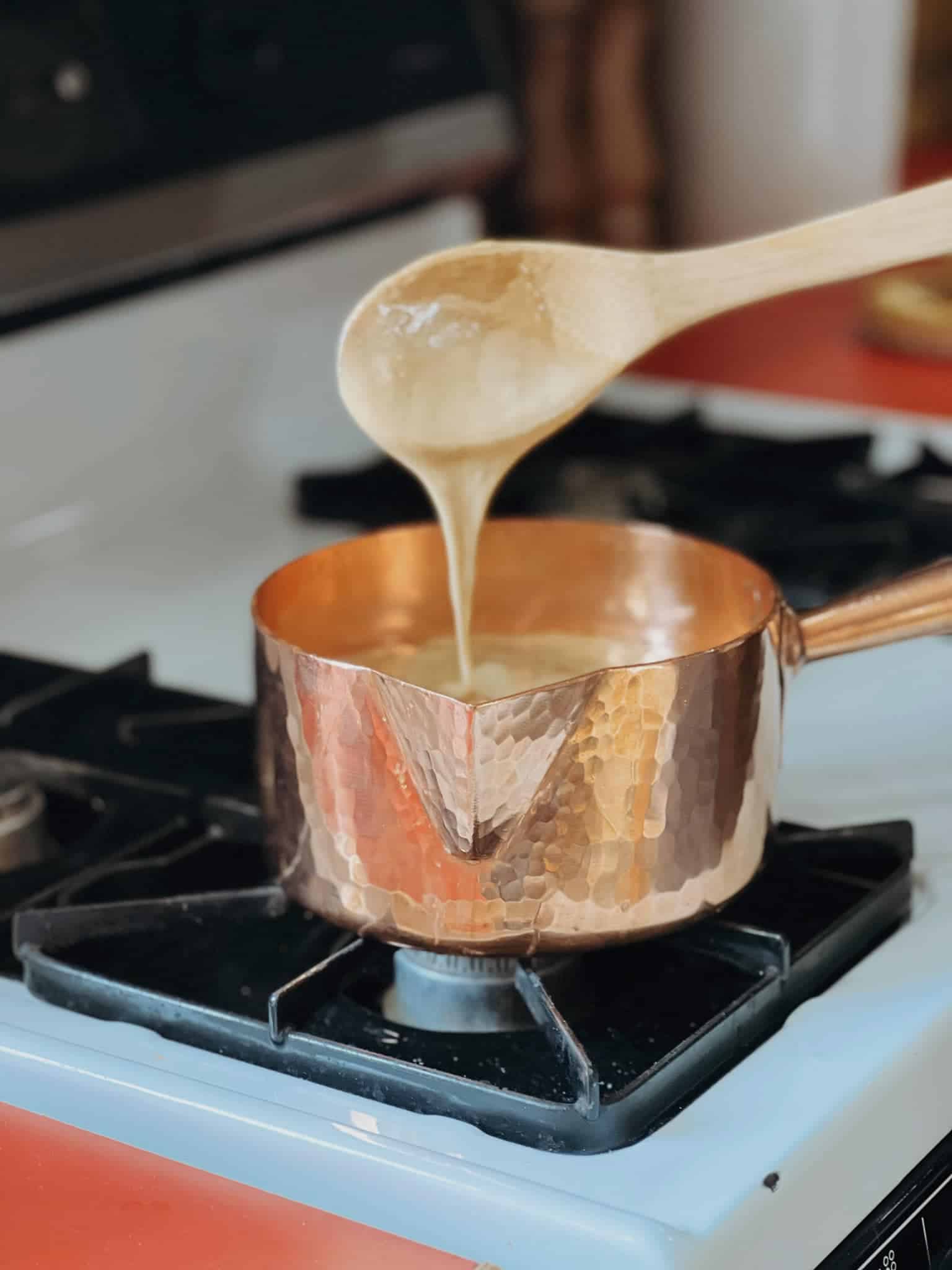

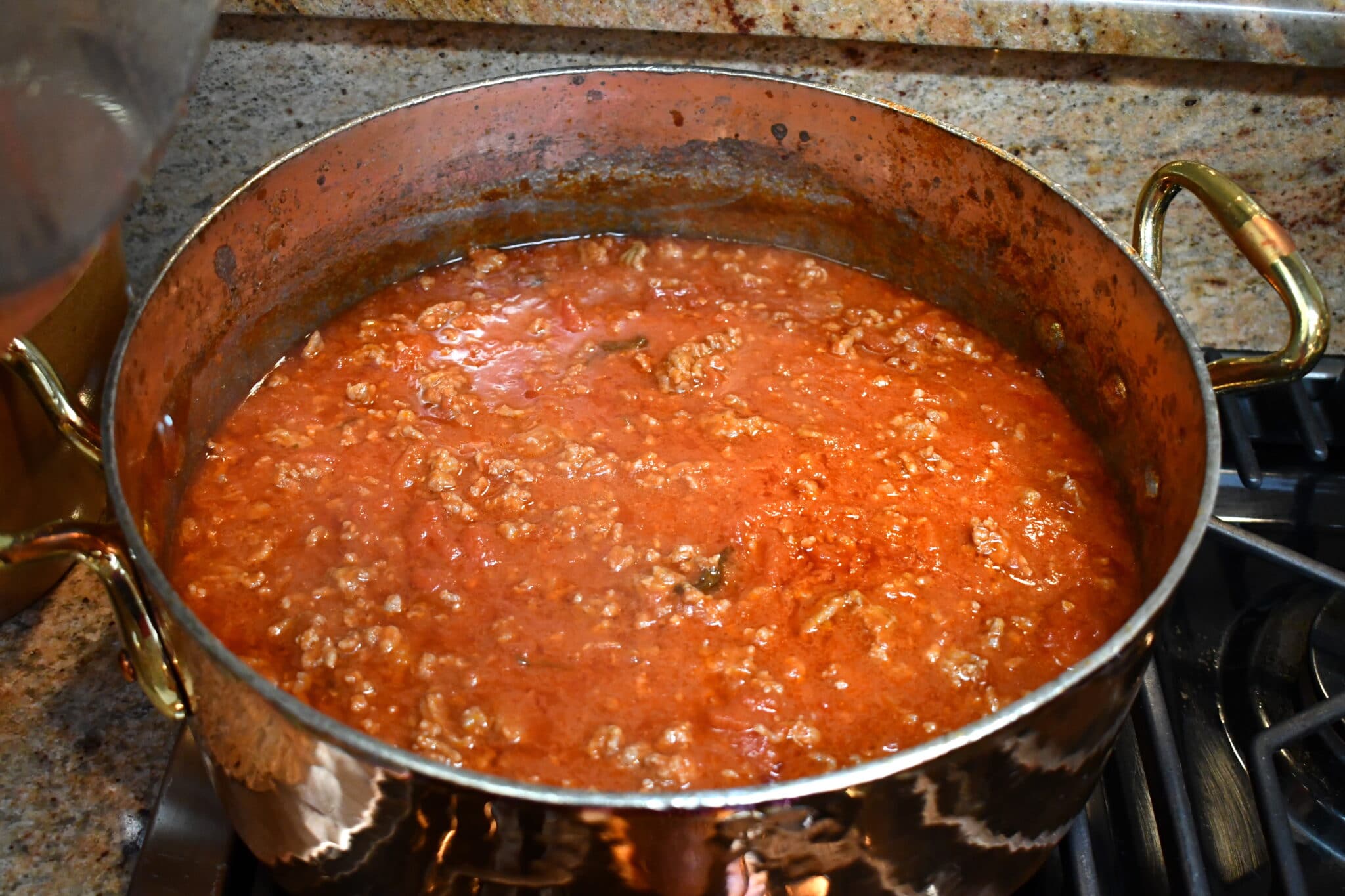
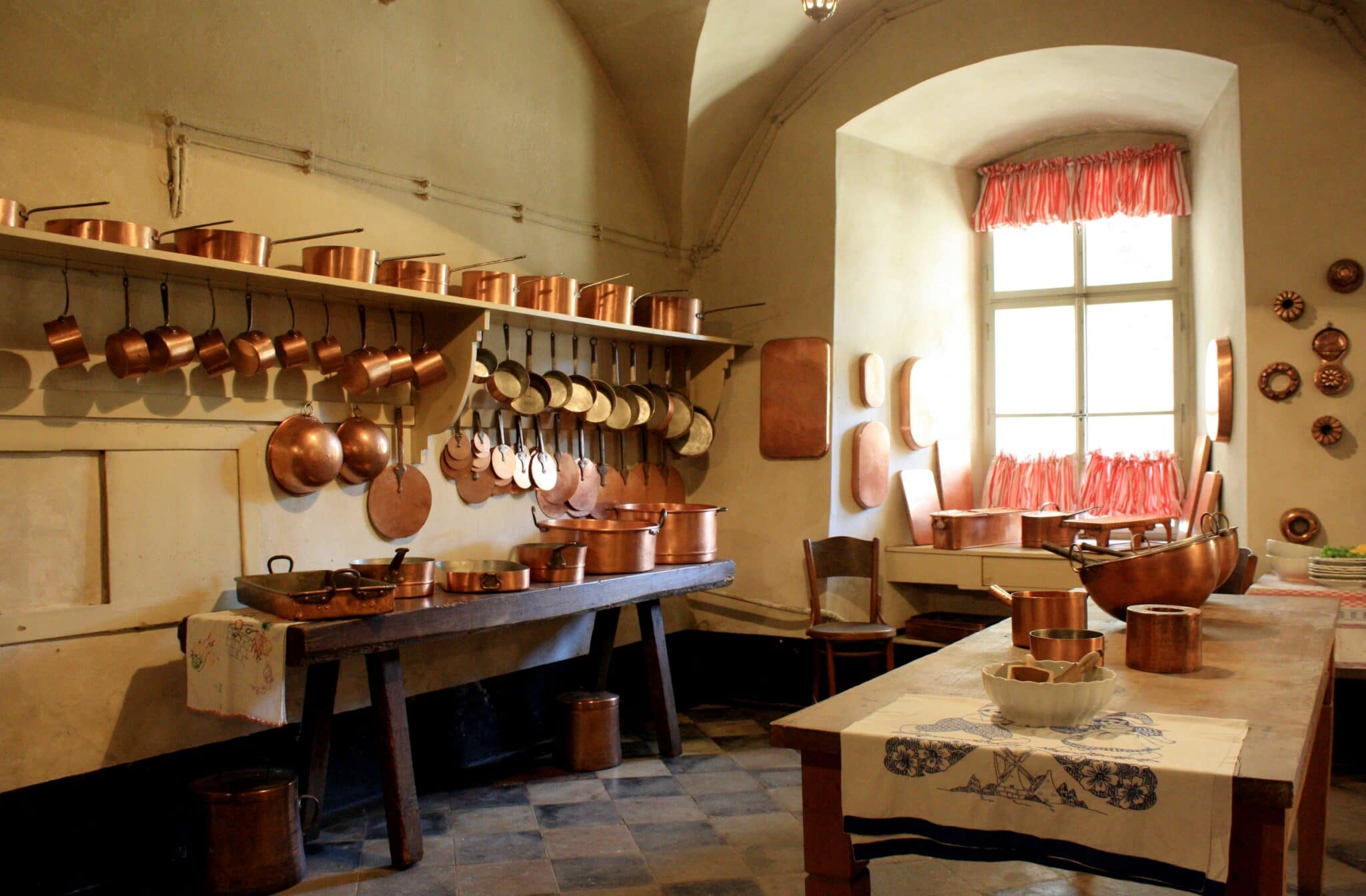

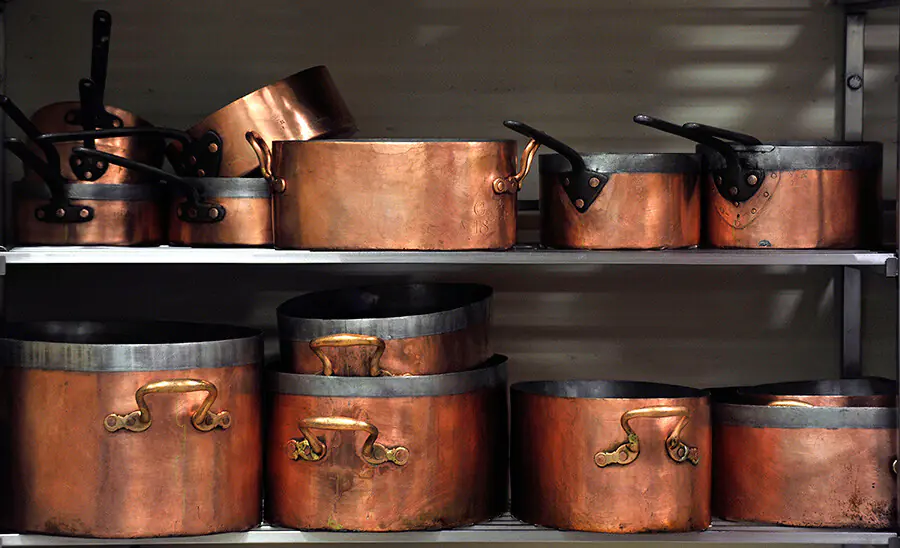
Un régal pour les yeux !
A feast for the eyes!
…. described by a loving eagle eye.
Obviously, there were times when fashions did not change constantly and people did not run after every zeitgeist. Today, home furnishings hardly survive a single generation. I find it amazing that even very wealthy people had things repaired several times when necessary instead of replacing them. Today, repairs, if they can be done at all, are usually more expensive than new purchases.
There is no doubt that the triangular or arrow-shaped handle plates are a characteristic feature of English pans. But there must be exceptions. I own a tall saucepan (16×17 cm, 2.7 kg) stamped by Dehillerin from 1890-1900 with just such a handle. And it’s not the only French pan/lid I’ve seen with these connecting plates. All tend to be from before 1900.
Regarding the large plate/lid with the ring-shaped handle: these handles are indeed hardly any good for handling. But they may have been easier and thus cheaper to make. Another small advantage I can see is the slightly smaller space required in the oven, as with my Dehillerin gratin pan for W.L also from around 1900. My lid (32 cm, 3.7 kg) with Meret France stamp, which can also be used as a skillet, also has only rings. Finally, just recently I saw a huge copper plate with ring handles touted for baking La Socca (Crêpes Nice). Not everything antique is practical or ergonomic.
I continue to be preoccupied with my ” outlier ” Dehillerin saucepan with the arrow-shaped handle rest. So I searched my archives for English pans with arrow-shaped handle supports. In doing so, I noticed that their arrows usually formed an equilateral triangle and always had fairly straight edges and sharp angles, as seems to be the case with Chateau de Montgeoffroy pan and lid #9.So probably an “immigrant” as VFC recognized this immediately. The arrow of my Dehillerin saucepan, however, forms an equilateral triangle, so it is a bit more elongated and the edges are quite light, the corners clearly rounded. Irritating, however, is the eyelet, which (rounded at the top, angular at the bottom with slightly conical sides) is again reminiscent of English manufacturers, but can also be found in a similar design at Allez Freres and Lefevre. Variants of the “defused” arrow can also be seen on some pans from the department store “A la Menagere”. Presumably, this is an early design, because in the further course of the arrow of the pans of the department store turned into a kind of leaf.
Martin, thank you for your thoughtful observations! For me one of the great pleasures of antique copper is to appreciate how well they have survived all this time — and the implicit message they have to tell about the persistence of quality.
To your comments on the arrow-shaped baseplate: I, too, have seen triangular baseplates on known French pieces. For example many bains marie a sauce — narrow pots with iron stick handles — have inverted triangle baseplates, though the point of the arrow is not as sharp as it is on a known English piece. (I believe it was Roger W. who suggested that the arrow shape of the baseplate may have been a visual pun for the English “broad arrow,” a military heraldry mark derived from the great English longbow in the Middle Ages.) The inverted triangle arrangement of rivets is a good practical one (and was adopted for the custom-designed French pieces for the Parisian stores as you note). And finally, there will always be exceptions to the “rules” about handle designs: I have seen French pieces stamped for English stores and I expect there was a great deal more cross-border trade than we can reasonably track now.
The arrow baseplate on #9 looks sharp like an English piece to me but I will go back and amend my statement from “definitely” English to “looks like” English in recognition of your point!
I am so glad you enjoyed the post and thank you again, as always, for your comments.
A great show but it looks like scene dressing to me, the pieces are too small & similar in size, very domestic looking. That is a milk churn on the top shelf & where are the really big stockpots etc. I also want to see some owner marks in such a grand residence.
The table has an oversized top to allow it to be used for dining & that is what the room set for (note the chairs in the photo with the people in).
Certainly, the photos do not show the kitchen in “working condition”. Rather, a collection of copper cooking vessels that has grown over many decades is shown. Since the castle can be visited, all rooms are presented in a visitor-friendly way and as perfectly as possible. If I missed something, it was a different perspective of the kichen, so that the cooking area can also be viewed. After some searching, I found supplementary information, including a photo of the fireplace. So a cooking area similar to what is shown in the drawings of the Windsor Castle kitchen. The castle did not have a more modern wood-fired hearth (hob, stove).
However, Chateau de Montgeoffroy does not seem to have catered for larger parties. Because the table in the kitchen can be set for a maximum of 6-8 people, as further photos show. An extremely elegant dining room also only offers (ample) space for 6 people. There does not seem to be a larger dining room in this castle. With the cooking vessels presented, including several daubieres and larger cauldrons, the culinary needs of so few people should have been easily satisfied.
Stamps and ownership marks: If VFC or another collector had had the opportunity to take close-up photos of the pots, some would probably be seen.
I’m not convinced, the only linking factor that I can see in the close-up is that none of the pans has a high financial value (under 50usd a piece). Of course the daubieres are sought after but not rare. I could recreate this batterie from online sellers in a matter of weeks. In 1960/70’s France it would have been even easier & cheaper. Taxidermy does not belong in a kitchen, it is impossible to clean. The Windsor deer head is carved wood. Compare the table with the ones at Windsor, the top should not overhang the base & would have been thick enough to stand repeated scraping & scrubbing like a butcher’s block. No one would have eaten in a kitchen anymore than people do in commercial kitchens today. Even staff would have a room to eat away from the kitchen.
I have searched and failed to find any history of this house in the first half of the 20th century, the period is skipped over until renovations in the second half. These five decades cover the two wars when most great houses were used by army or as hospitals and often suffered damage & looting.
Roger, I see your points. I also failed to find much information about the house in recent years and I don’t know whether they represent the copper as original to the residence or not. Have any readers been to the place who can comment on how the collection is presented?
My goodness that is a beautiful display. I could only hope for that at some point in my lifetime.
I am slowly building up my collection, too slowly lol.
A few articles on best ways to store and display copper cookware in modern kitchens may be a great idea.
Long bars with hooks seem the way to go, but really impracticable in most modern kitchens. Restaurant kitchen stove units sometimes have a bar over the burner surface for storing pots.
Cabinets are about 18” from counter tops, too narrow, and storing over cabinets at 80” from the floor would be too high. Maybe an alcove of 12” deep shelves could work, however, that would require remodeling.
Bob, that’s a great idea. My own kitchen has limited storage space and I can’t provide good examples. Would any readers be interested in sharing their storage solutions?
Roger, you make a harsh judgment about the presented pots especially since the resolution of the photos makes an appropriate assessment difficult. Some time ago I had two pans in hand, which came from archducal property (Marienburg Castle, Hanover) and were stamped accordingly. Manufacture probably in the first half of the 19th century. I was surprised by the thin quality of the copper with numerous dents and deformations. Copper pots of the Royal House of Bavaria were also partly made of thin copper, as I could see at auctions. Even individual pans owned by the Rothschild family, who really did not have to economize, were made of thinner copper. I could go on listing famous names stamped in thin copper. So I’m not sure that the quality standards of Gaillard or Dehillerin can be applied to pans made before 1850 and used in chateau kitchens. Also, consider the plain furnishings of the Windsor Castle kitchen in some paintings. The cooking utensils in the kitchen of Germany’s most visited castle, Neuschwanstein, doesn’t knock my socks off either.
Today, many castles or palaces are opened to the public by their owners (aristocrats or public authorities) in order to finance their renovation and maintenance through the proceeds. They are therefore a kind of museum and accordingly decoratively equipped. One should understand the equipment of this kitchen probably rather as a kind of theater decoration in the style of originals of this time. Since it is quite obvious that cooking and eating in this kitchen has not taken place for a long time, the stuffed animals or animal dummies only serve as hunting symbols and do not affect hygiene. Whether one likes such things is another matter. Even the beautifully set table in the kitchen, which I saw in other photos, is only to be understood as a decorative arrangement. However, I can imagine that especially the kitchen staff could actually dine there in the past. The aristocratic owners certainly dined in other rooms.
The chateau together with its inventory “miraculously” survived the consequences of the French Revolution. ORIGINAL furniture, carpets, paintings …. and an “outstanding collection of 260 copper and pewter pieces” were preserved and can be presented to the public today.
https://www.chateaudemontgeoffroy.com/gb/
Play a little with the site. You will find beautiful photos of the castle, its interiors and furnishings, and the surrounding area.
Just now I see on ebay US a saucepan (6.5 “x7”) from J. Gaillard, which has some similarities with my variant from Dehillerin. In particular, the handle with an arrow-shaped support stands out. Only the eyelet is cut out a little differently. While my Dehillerin saucepan with stamp from 1890-1900 was made from one piece of copper sheet, the Gaillard variant is dovetailed. Unusually for a French saucepan, the teeth of the inset bottom are widely spaced. Curious.